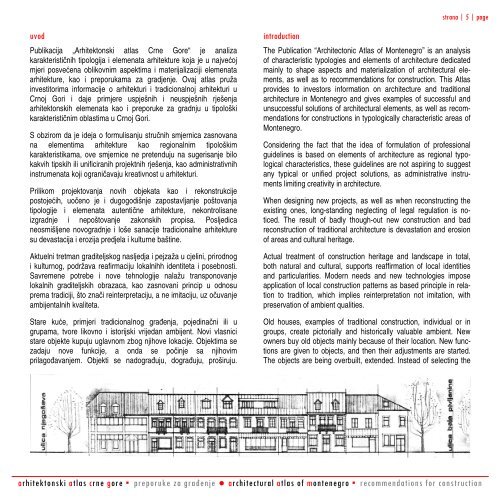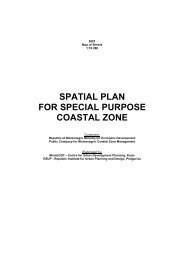arhitekonski atlas crne gore - Ada Bojana
arhitekonski atlas crne gore - Ada Bojana
arhitekonski atlas crne gore - Ada Bojana
You also want an ePaper? Increase the reach of your titles
YUMPU automatically turns print PDFs into web optimized ePapers that Google loves.
uvod<br />
Publikacija „Arhitektonski <strong>atlas</strong> Crne Gore“ je analiza<br />
karakterističnih tipologija i elemenata arhitekture koja je u najvećoj<br />
mjeri posvećena oblikovnim aspektima i materijalizaciji elemenata<br />
arhitekture, kao i preporukama za gradjenje. Ovaj <strong>atlas</strong> pruža<br />
investitorima informacije o arhitekturi i tradicionalnoj arhitekturi u<br />
Crnoj Gori i daje primjere uspješnih i neuspješnih rješenja<br />
arhitektonskih elemenata kao i preporuke za gradnju u tipološki<br />
karakterističnim oblastima u Crnoj Gori.<br />
S obzirom da je ideja o formulisanju stručnih smjernica zasnovana<br />
na elementima arhitekture kao regionalnim tipološkim<br />
karakteristikama, ove smjernice ne pretenduju na sugerisanje bilo<br />
kakvih tipskih ili unificiranih projektnih rješenja, kao administrativnih<br />
instrumenata koji ograničavaju kreativnost u arhitekturi.<br />
Prilikom projektovanja novih objekata kao i rekonstrukcije<br />
postojećih, uočeno je i dugogodišnje zapostavljanje poštovanja<br />
tipologije i elemenata autentične arhitekture, nekontrolisane<br />
izgradnje i nepoštovanje zakonskih propisa. Posljedica<br />
neosmišljene novogradnje i loše sanacije tradicionalne arhitekture<br />
su devastacija i erozija predjela i kulturne baštine.<br />
Aktuelni tretman graditeljskog nasljedja i pejzaža u cjelini, prirodnog<br />
i kulturnog, podržava reafirmaciju lokalnihh identiteta i posebnosti.<br />
Savremene potrebe i nove tehnologije nalažu transponovanje<br />
lokalnih graditeljskih obrazaca, kao zasnovani princip u odnosu<br />
prema tradiciji, što znači reinterpretaciju, a ne imitaciju, uz očuvanje<br />
ambijentalnih kvaliteta.<br />
Stare kuće, primjeri tradicionalnog građenja, pojedinačni ili u<br />
grupama, tvore likovno i istorijski vrijedan ambijent. Novi vlasnici<br />
stare objekte kupuju uglavnom zbog njihove lokacije. Objektima se<br />
zadaju nove funkcije, a onda se počinje sa njihovim<br />
prilagođavanjem. Objekti se nadograđuju, dograđuju, proširuju.<br />
introduction<br />
strana | 5 | page<br />
The Publication “Architectonic Atlas of Montenegro” is an analysis<br />
of characteristic typologies and elements of architecture dedicated<br />
mainly to shape aspects and materialization of architectural elements,<br />
as well as to recommendations for construction. This Atlas<br />
provides to investors information on architecture and traditional<br />
architecture in Montenegro and gives examples of successful and<br />
unsuccessful solutions of architectural elements, as well as recommendations<br />
for constructions in typologically characteristic areas of<br />
Montenegro.<br />
Considering the fact that the idea of formulation of professional<br />
guidelines is based on elements of architecture as regional typological<br />
characteristics, these guidelines are not aspiring to suggest<br />
any typical or unified project solutions, as administrative instruments<br />
limiting creativity in architecture.<br />
When designing new projects, as well as when reconstructing the<br />
existing ones, long-standing neglecting of legal regulation is noticed.<br />
The result of badly though-out new construction and bad<br />
reconstruction of traditional architecture is devastation and erosion<br />
of areas and cultural heritage.<br />
Actual treatment of construction heritage and landscape in total,<br />
both natural and cultural, supports reaffirmation of local identities<br />
and particularities. Modern needs and new technologies impose<br />
application of local construction patterns as based principle in relation<br />
to tradition, which implies reinterpretation not imitation, with<br />
preservation of ambient qualities.<br />
Old houses, examples of traditional construction, individual or in<br />
groups, create pictorially and historically valuable ambient. New<br />
owners buy old objects mainly because of their location. New functions<br />
are given to objects, and then their adjustments are started.<br />
The objects are being overbuilt, extended. Instead of selecting the<br />
arhitektonski <strong>atlas</strong> <strong>crne</strong> <strong>gore</strong> ▪ preporuke za građenje ● architectural <strong>atlas</strong> of montenegro ▪ recommendations for construction



